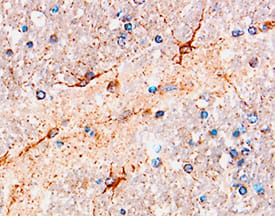Human beta-NGF Antibody
R&D Systems, part of Bio-Techne | Catalog # AF-256-NA


Key Product Details
Species Reactivity
Validated:
Cited:
Applications
Validated:
Cited:
Label
Antibody Source
Product Specifications
Immunogen
Ser122-Ala241
Accession # CAA36832
Specificity
Clonality
Host
Isotype
Endotoxin Level
Scientific Data Images for Human beta-NGF Antibody
Cell Proliferation Induced by beta‑NGF and Neutralization by Human beta‑NGF Antibody.
Recombinant Human beta-NGF (Catalog # 256-GF) stimulates proliferation in the TF-1 human erythroleukemic cell line in a dose-dependent manner (orange line). Proliferation elicited by Recombinant Human beta-NGF (5 ng/mL) is neutralized (green line) by increasing concentrations of Goat Anti-Human beta-NGF Antigen Affinity-purified Polyclonal Antibody (Catalog # AF-256-NA). The ND50 is typically 0.02-0.08 µg/mL.beta‑NGF in Human Brain.
beta-NGF was detected in immersion fixed paraffin-embedded sections of human brain using Goat Anti-Human beta-NGF Antigen Affinity-purified Polyclonal Antibody (Catalog # AF-256-NA) at 10 µg/mL overnight at 4 °C. Tissue was stained using the Anti-Goat HRP-DAB Cell & Tissue Staining Kit (brown; Catalog # CTS008) and counterstained with hematoxylin (blue). Specific staining was localized to axons. View our protocol for Chromogenic IHC Staining of Paraffin-embedded Tissue Sections.Applications for Human beta-NGF Antibody
Immunohistochemistry
Sample: Immersion fixed paraffin-embedded sections of human brain subjected to Antigen Retrieval Reagent-Basic (Catalog # CTS013)
Western Blot
Sample: Recombinant Human beta-NGF (Catalog # 256-GF)
Neutralization
Reviewed Applications
Read 2 reviews rated 4 using AF-256-NA in the following applications:
Formulation, Preparation, and Storage
Purification
Reconstitution
Formulation
Shipping
Stability & Storage
- 12 months from date of receipt, -20 to -70 °C as supplied.
- 1 month, 2 to 8 °C under sterile conditions after reconstitution.
- 6 months, -20 to -70 °C under sterile conditions after reconstitution.
Background: beta-NGF
NGF was initially isolated in the mouse submandibular gland as a 7S complex composed of three non-covalently linked subunits, alpha, beta, and gamma. Both the alpha and gamma subunits of NGF are members of the kallikrein family of serine proteases while the beta subunit, called beta-NGF or 2.5S NGF, exhibits all the biological activities ascribed to NGF. Recombinant human beta-NGF is a homodimer of two 120 amino acid polypeptides. The human protein shares approximately 90% homology at the amino acid level with both the mouse and rat beta-NGF and exhibits cross-species activity.
NGF is a well-characterized neurotropic protein that plays a critical role in the development of sympathetic and some sensory neurons in the peripheral nervous system. In addition, NGF can also act in the central nervous system as a trophic factor for basal forebrain cholinergic neurons. NGF has also been shown to have biological effects on non-neuronal tissues. NGF is mitogenic for a factor-dependent human erythroleukemic cell line, TF-1. NGF has been found to increase the number of mast cells in neonatal rats and to induce histamine release from peritoneal mast cells. NGF will enhance histamine release and strongly modulate the formation of lipid mediators by basophils in response to various stimuli. NGF will also induce the growth and differentiation of human B lymphocytes as well as suppress apoptosis of murine peritoneal neutrophils. These results, taken together, suggest that NGF is a pleiotropic cytokine which, in addition to its neurotropic activities, may have an important role in the regulation of the immune system.
Long Name
Alternate Names
Gene Symbol
UniProt
Additional beta-NGF Products
Product Documents for Human beta-NGF Antibody
Product Specific Notices for Human beta-NGF Antibody
For research use only
